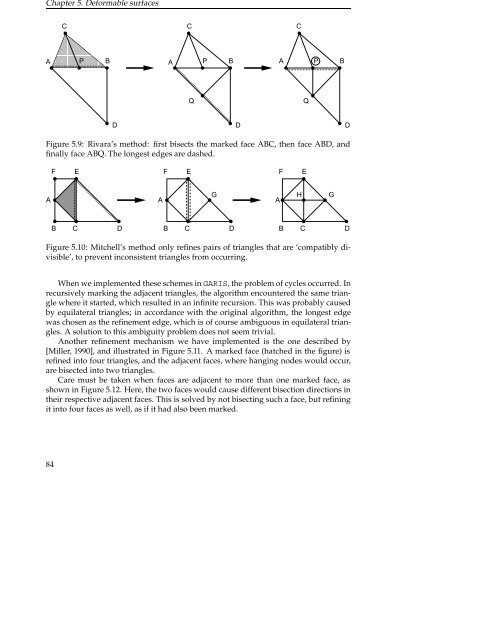Chapter 4 Vortex detection - Computer Graphics and Visualization
Chapter 4 Vortex detection - Computer Graphics and Visualization
Chapter 4 Vortex detection - Computer Graphics and Visualization
You also want an ePaper? Increase the reach of your titles
YUMPU automatically turns print PDFs into web optimized ePapers that Google loves.
<strong>Chapter</strong> 5. Deformable surfaces<br />
C<br />
<br />
<br />
<br />
<br />
C C<br />
A<br />
P B<br />
<br />
<br />
A P B<br />
A P B<br />
D<br />
Q<br />
Figure 5.9: Rivara’s method: first bisects the marked face ABC, then face ABD, <strong>and</strong><br />
finally face ABQ. The longest edges are dashed.<br />
F<br />
E<br />
G<br />
A A<br />
A<br />
B C<br />
F<br />
E<br />
D B C<br />
D<br />
B C<br />
D<br />
Figure 5.10: Mitchell’s method only refines pairs of triangles that are ‘compatibly divisible’,<br />
to prevent inconsistent triangles from occurring.<br />
When we implemented these schemes in GARIS, the problem of cycles occurred. In<br />
recursively marking the adjacent triangles, the algorithm encountered the same triangle<br />
where it started, which resulted in an infinite recursion. This was probably caused<br />
by equilateral triangles; in accordance with the original algorithm, the longest edge<br />
was chosen as the refinement edge, which is of course ambiguous in equilateral triangles.<br />
A solution to this ambiguity problem does not seem trivial.<br />
Another refinement mechanism we have implemented is the one described by<br />
[Miller, 1990], <strong>and</strong> illustrated in Figure 5.11. A marked face (hatched in the figure) is<br />
refined into four triangles, <strong>and</strong> the adjacent faces, where hanging nodes would occur,<br />
are bisected into two triangles.<br />
Care must be taken when faces are adjacent to more than one marked face, as<br />
shown in Figure 5.12. Here, the two faces would cause different bisection directions in<br />
their respective adjacent faces. This is solved by not bisecting such a face, but refining<br />
it into four faces as well, as if it had also been marked.<br />
84<br />
D<br />
F<br />
H<br />
Q<br />
E<br />
G<br />
D

















